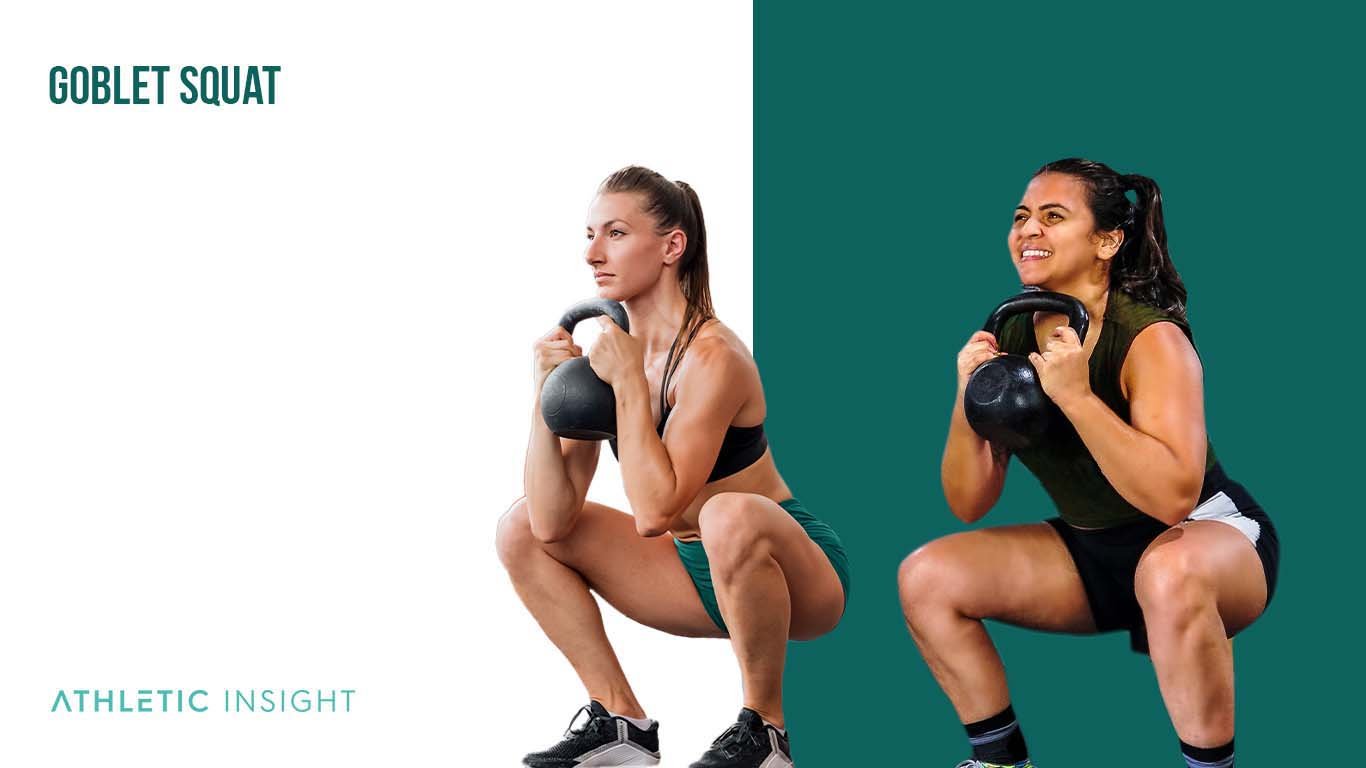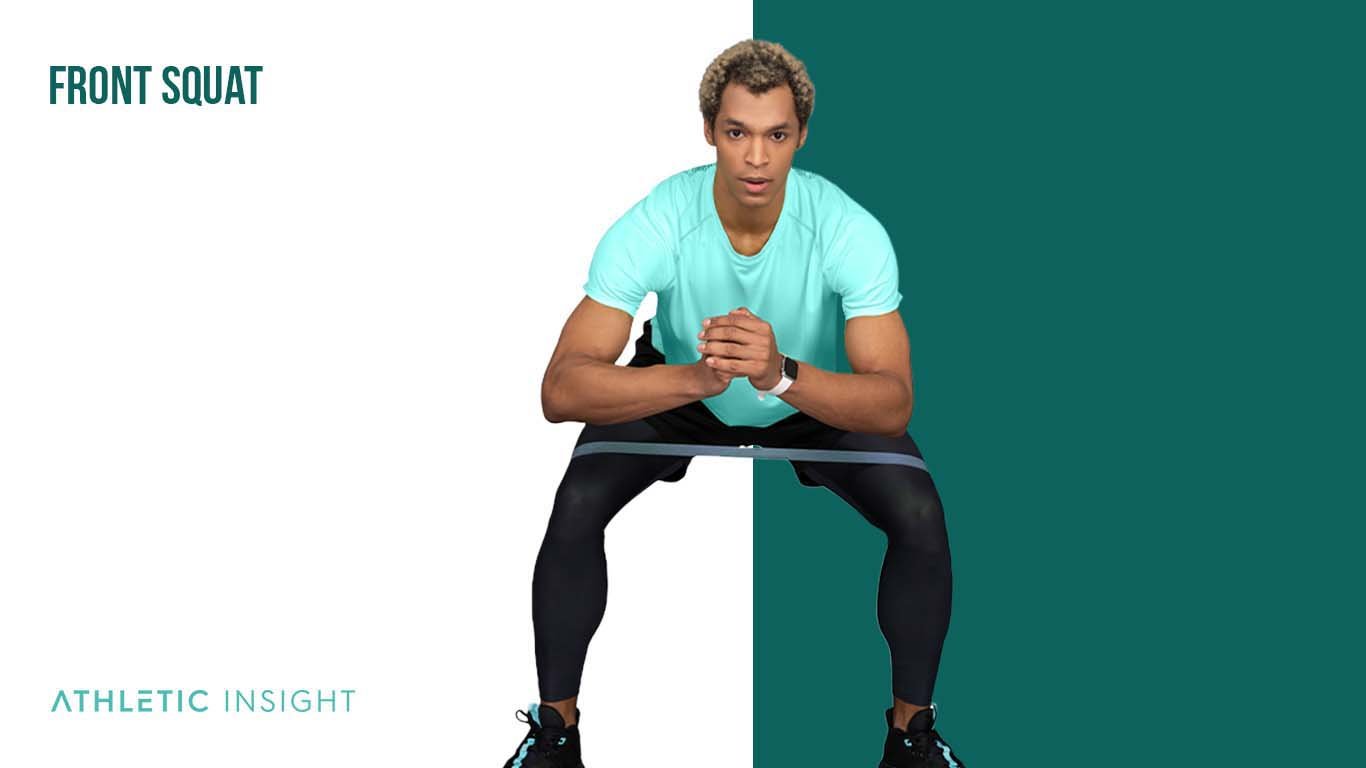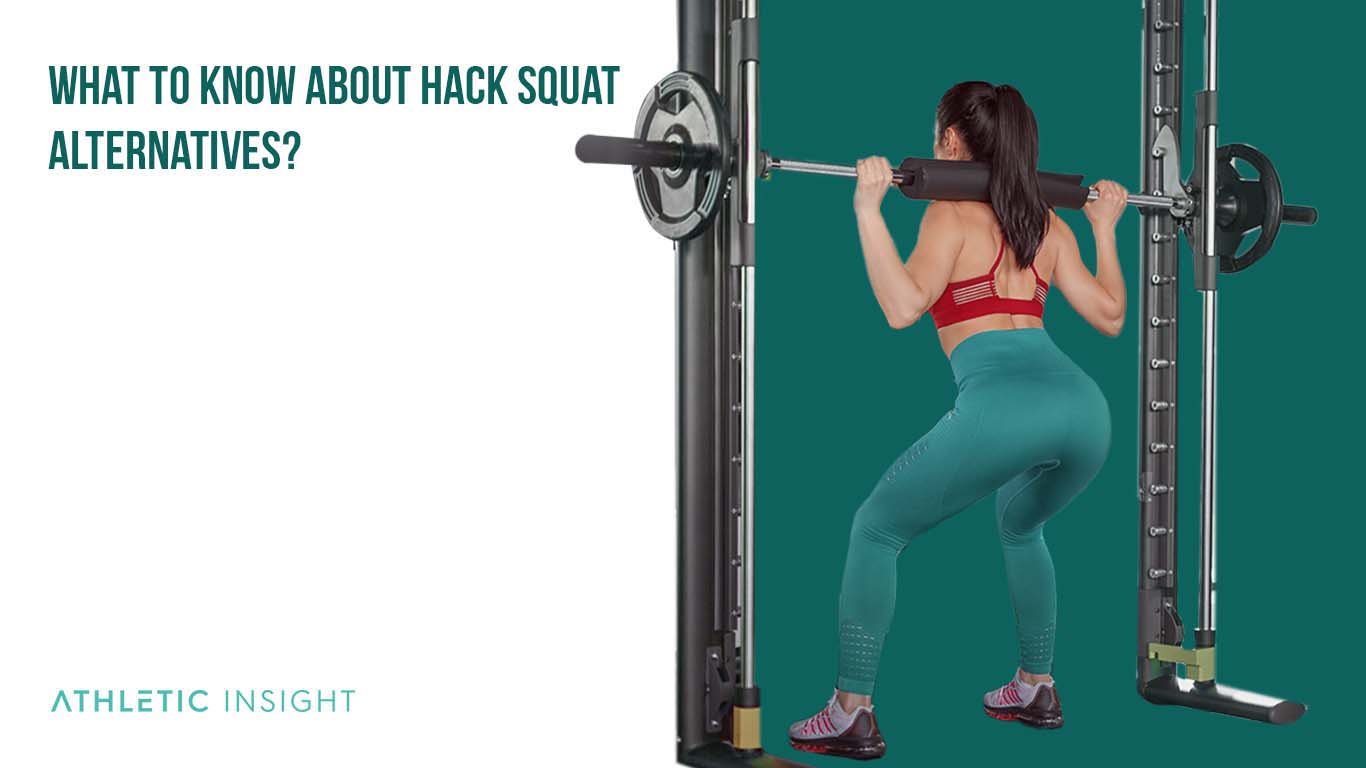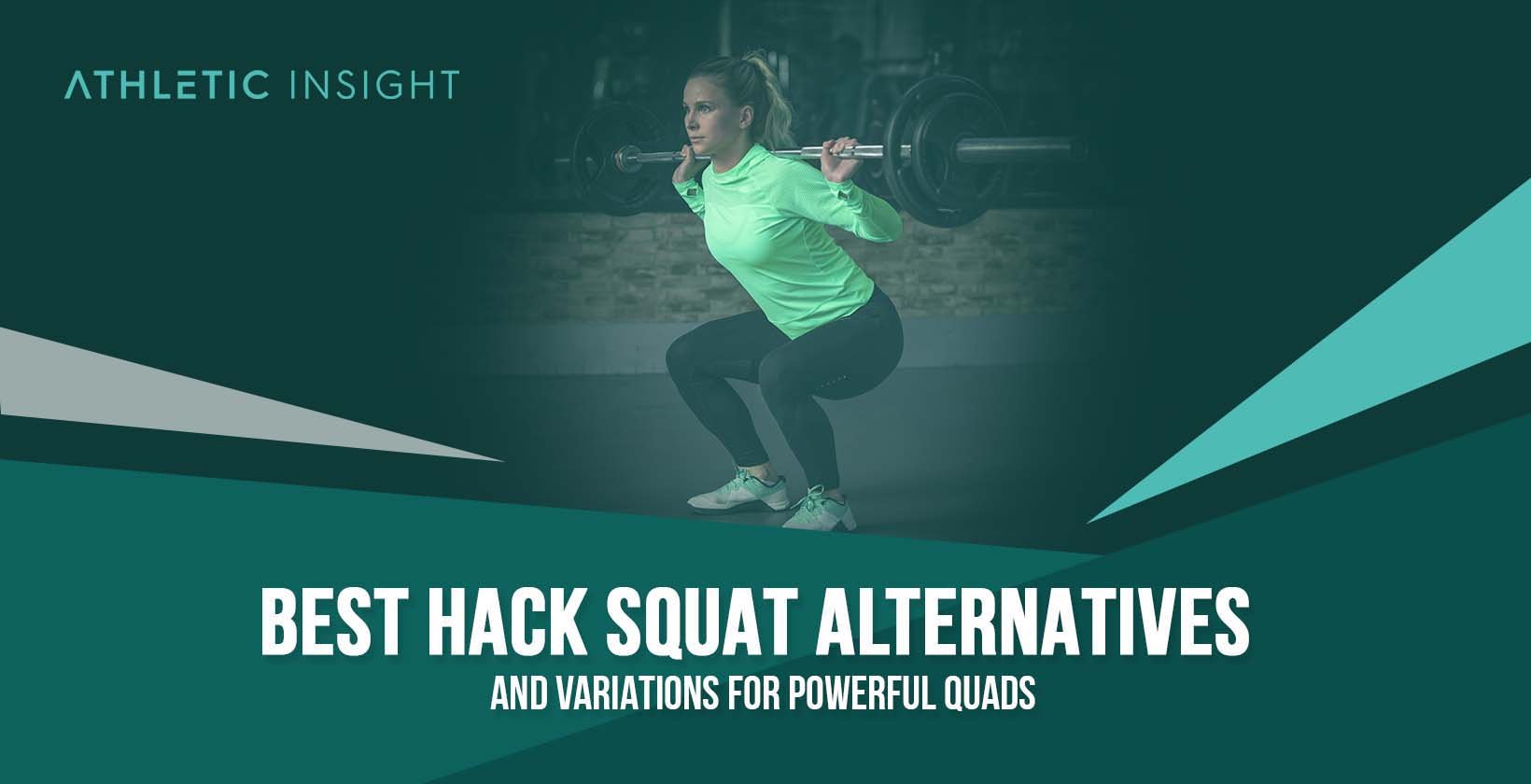The hack squat, which works the entire lower body from the glutes and hamstrings to quads and calves, is a versatile variation on the squat exercise. The exercise is done on a machine, with the legs standing on a plate and the back pressed against the pads. While squatting, the weight on the machine moves with the body.
The hack squat tends to be especially popular for anyone who wants to build their leg muscles but is still a beginner to the squat exercise. Using the angled machine can safely support your weight and even help you improve your general squat form in the future.
Even if you don’t have a hack squat machine available or are just looking for a similar exercise that targets more specific muscles in the lower body, there are 12 excellent alternatives to the hack squat – like the goblet squat that only requires dumbbells or the landmine squat, which also works the deltoids and trapezius muscles.
Hack squat alternatives tend to be more beneficial for specific muscles, including the gastrocnemius, hamstrings, and glutes, even if they aren’t always as popular or as well-known as the default hack squat.
Certain alternatives, like the safety bar squat, can also be more beginner-friendly as well. Here are twelve different hack squat alternatives and variations to swap in for the traditional hack squat.
1. Goblet Squat
The goblet squat is a hack squat alternative with dumbbells that touches on several muscle groups, including the glutes, quads, hamstrings, and triceps surae muscles, along with the arms and shoulders.

The goblet squat is ideal for beginner weightlifters looking for a warm-up exercise that’ll also help build muscle. It’s an excellent exercise for both women and men and muscle building.
If you’ve been working to improve your squat form, the goblet squat is a great exercise to help. The movements you’ll need for the goblet squat force the body into a chest-up position that any squat calls for.
Since the goblet squat calls for a dumbbell, you won’t need to worry about using any machine. It also makes it a great hack squat alternative at home if you’re away from a machine. For best results, keep your elbows close to your torso when lifting, which will help prevent soreness in your wrists.
A common mistake with this exercise is posture. You’ll want to keep the back neutral and protect the wrists.
Be careful about holding the weight too far from the body or leaning too forward when squatting down, which could compromise the neutral position of the spine.
Go with the goblet squat when you need a warm-up to your regular arm routine. This exercise is beginner level.
The goblet squat has four different variations. The variations are the dumbbell goblet squat, the kettlebell top-up goblet squat, the kettlebell bottom up goblet squat, and the kettlebell side goblet squat.
2. Leg Press
The leg press is a machine-based hack squat alternative that targets the glutes and quadriceps femoris. It’s ideal for weightlifters who need accommodations for back or knee pain. It’s a simple exercise to do and can be scaled to suit your comfort when lifting.
In addition to working the same muscles as the hack squat, the leg press avoids spinal compression, making this ideal for lifters who suffer from back pain.
If you’ve found yourself tiring out quickly with specific weight-based exercises, such as the goblet squat, the leg press is an excellent alternative to a hack squat. It won’t tire you out as quickly, but you’ll still get a beneficial workout. The leg press is also an excellent narrow-stance hack squat alternative.
One common mistake with the leg press is not keeping the rear flat against the seat. Lifting the butt will cause the legs to bend incorrectly.
Readjust positioning if you feel cramped or your knees are at eye level. In addition, take care not to overdo it on weight. Start low, then gradually build up as you become more comfortable.
This exercise is best suited to men and weightlifters. The leg press variation has five main variations, including the following.
- Low foot placement leg press
- High foot placement leg press
- Narrow leg foot press
- Wide leg foot press
These variations depend on the positioning of the legs during the exercise. The wide food press exercise is best for the inner quads of the leg, and the narrow foot positioning allows for targeting the outer quads.
3. Front Squat
This free-weight variation gives the quads and glutes a great workout. It’s great for weightlifters who are both men and women under 50 that deal with upper back pain since the position won’t compress the spine.

As a bonus, the added weight of the barbell across the collarbone offers a good upper-body workout, too. The front squat will also be a good choice for those looking for a reverse hack squat alternative.
This exercise is more advanced, so for those just starting with squats, consider one of the other alternatives for the hack squat listed here.
A common mistake with the front squat is incorrect grip. To avoid injury, always make sure to take the time to grip firmly on the bar.
Sometimes, the grip used for the front squat can cause wrist pain. Try switching to an overhand grip to give the wrists a break if that happens. Also, be sure to place the hook at clavicle height when loading the bar, so you don’t have to slouch or stand on your toes to lift the bar.
Several front squat variations are available to try for differing difficulty levels. They include the following.
- Band resistant front squats
- Front squat lockouts
- Bottom-half front squats
4. Landmine Squat
The landmine squat is a full-body hack squat alternative that targets the quads, glutes, abdominal rectus muscle, hamstrings, deltoids, and trapezius muscles. It works well for beginner athletes or fitness enthusiasts who are just learning how to do squats.
If the weight on the barbell has become a bit too awkward to manage, using a landmine attachment will make the weight a bit more manageable.
If you don’t have a landmine attachment, you can simply use the corner of your wall to balance the bar. Just be aware that there is a risk of damaging the wall doing so. The main downside to the landmine squat is that you’ll be a bit limited on how much weight to use.
A common mistake while performing the landmine squat is using the incorrect weight at first. Start small and build up with this exercise.
The landmine squat is a great variation of the hack squat for women. Athletes needing a squat routine to start the day should try the landmine squat.
While performing the squat, keep the back straight and build up the weight over time. Use this as a beginner exercise and hack squat alternative before moving on to more advanced alternatives.
The landmine squat has several alternatives. The alternatives include the following.
- Landmine box squats
- Landmine thruster squats
- Landmine hack squats
5. Belt Squat
The belt squat works the muscles in most of the lower body, including the glutes, hamstrings, gastrocnemius, and quadriceps femoris. This exercise is ideal for weightlifters or bodybuilders that struggle with back pain and athletes who want a faster recovery time than they get with the hack squat.
Many lifters favor the hack squat because it takes the strain off their back while lifting. If you need a substitute for similar purposes, you can incorporate the belt squat instead. Since the belt squat loads all of the weight below your waist, you’ll be able to relieve pressure on your back while still working your hamstrings and quads.
Since it only works your lower body, you may also find that the recovery time is a little faster between sets, at least compared to the front/back squats.
While performing the belt squat, one mistake is using a thin belt and using the wrong shoes.
The belt squat has a few variations that involve various pieces of equipment, so you’ll need to decide which suits you best. If you want to get more of a benefit out of the belt squat workout, invest in a pair of squat shoes. The shoes will help you do a deeper squat, which will help work the quads out even more.
To avoid injury, pay close attention to how the hips rise and ensure they don’t rise more quickly than the shoulders.
The belt squat has several variations. Try any of the following.
- Dumbbell belt squat
- Safety bar belt squat
- Landmine belt squat
6. Barbell Hack Squat
The barbell hack squat targets the rectus femoris, glutes, and quads and is especially popular with bodybuilders with a little more experience and training.
This exercise is a hack squat machine alternative because it offers most of the same benefits while helping perfect your squat form. It’s a bit more complex than the other alternatives on this list, so it’s not ideal for beginners. However, it’s a beneficial exercise for the lower body muscle groups once you get the hang of it.
The barbell hack squat can be tricky to master because it requires you to focus on keeping your knees balanced as you lift the bar behind you.
Since it’s a free-weight exercise, you won’t have the benefit of a machine to help with balance. If you struggle too much, try shifting to a different exercise that won’t cause you as much difficulty.
The most common mistake with the barbell hack squat is improper stance. Keep your feet planted and sustain the proper back form, so you do not drop the weight or hurt your back muscles.
This exercise is best for men and is excellent for experienced athletes. The barbell hack squat has no specific variations.
7. Hatfield Squat
The Hatfield squat targets the quadriceps, femoris, and glute muscles and is especially popular for weightlifters that have strong backs but weaker legs.
The Hatfield squat is one of two alternatives for hack squats on this list that uses a safety bar. It forces the torso to remain vertical while giving the glutes and quads an intense workout. It’s an ideal exercise for lifters suffering from or recovering from a back injury or who want to build strength and improve squat form.
Before attempting the Hatfield squat, take time to learn the barbell back squat first. It will help make doing this variation a bit easier. Also, don’t resign yourself to the hand supports on the machine. Instead, try out different supports to find which works best for you.
One mistake athletes make while doing the Hatfield squat is hand positioning on the bar. Make sure your hands are evenly spaced and that you have the proper grip.
This hack squat alternative has no variations to mention. However, you can use the barbell back squat as an alternative if you find this exercise too difficult.
8. Safety Bar Squat
The safety bar squat works the quadriceps, erector spinae muscles, gastrocnemius, and hamstrings. It’s best suited for powerlifters, strongmen, and bodybuilders who want to continue their strength training but avoid an injury.
For athletes recovering from a rotator cuff injury or suffering from tendonitis, the safety bar squat will be a good hack squat alternative.
One of the most common issues with the safety bar squat is that the bar itself tends to cause the lifter to lean forward. Although this gives the upper back (erector spinae muscles) a great workout that it won’t get with other squat alternatives, it can lead to balance issues.
If you start to struggle to balance when doing the safety bar squat, take a moment to brace your core and reset the position. It’ll take some practice, but it’ll be worth it. The safety bar squat is a favorite of many athletes, so once you get the hang of it, you’ll want to keep it a regular part of your routine.
There is no specific safety bar squat variations.
9. V-Squat
The V-squat exercise isolates and targets the quads, glutes, hamstrings, abs, and erector spinae muscles. It’s ideal for lifters and athletes of any gender and age that want a high-intensity leg workout.
The v-squat is a good alternative for reverse hack squats because the motions are nearly identical. However, it also has the added benefit of working the abs and erector spinae muscles because it requires the lifter to tilt forward.
Since this is a machine-based exercise, you don’t have to worry about the balance problems you might have with a free-weight squat. That makes this one ideal for beginners, but it can be just as beneficial for experienced lifters, too.
One common mistake with the V-squat exercise is not leading with the knees. Don’t lead the squat from the hips, or the knees can get injured.
For best results, position the feet a bit more closely together than you usually would. You’ll be able to target the quads more efficiently that way. Also, ensure your shoulders stay flush against the shoulder pads to avoid difficulty performing the exercise.
The V-squat has no specific variations.
10. Reverse Hack Squat Machine
The reverse hack squat machine targets the lower back muscles, quadriceps femoris, gluteus maximus and minus, and the hamstrings. It’s ideal for athletes and men that want to slim down while still maintaining and gaining muscle mass in the legs and lower body. It’s also beginner-friendly and doesn’t require much experience to execute effectively.
The reverse hack squat and hack squat are similar in that they both isolate the quads. If you’re familiar with the hack squat machine, you shouldn’t have any problem mastering the mechanics of the reverse hack squat. You can perform this hack squat alternative on a Smith machine.
The main difference between the hack squat and the reverse hack squat is where you bend. With a hack squat, you’ll get most of the exercise bending at the knee. However, the reverse hack squat requires you to bend at the hip. As a result, you’ll get just as much focus on the quads with the added benefit of targeting the hamstrings.
One of the most important things to remember when performing the reverse hack squat is to avoid bouncing, which is a common mistake. Also, elevating the heels will help you remain upright and keep the focus on the exercise on the quads, which is also good practice if you want to strengthen the shins.
11. Dumbbell Hack Squat
The dumbbell hack squat is a hack squat alternative exercise that targets the quads, hamstrings, and gluteus maximus. This exercise is ideal for beginner athletes and lifters, as well as those who may not have access to a hack squat machine or other equipment.
Both men and women can take advantage of this alternative to the hack squat. It’s a simple exercise, so you don’t need any special training to perform it.
One of the main benefits is that anyone can do this exercise at home. All that is needed is a set of dumbbells and a bit of space to bend.
A common mistake many beginners make is to use their knees to force their body weight down. When squatting, make sure you’re using the hips to squat, which will keep the necessary pressure on the thighs. For those who suffer from lower back pain, the barbell hack squat alternative will be a better option.
12. Single Leg Hack Squat
The single-leg hack squat isolates the quads, glutes, and hamstrings and is excellent for weightlifters and bodybuilders. It’s an excellent exercise for building strength and toning muscle. It’s a more advanced exercise, though, so it’s not ideal for beginners.
Both men and women can perform the single-leg hack squat.
During the single-leg hack squat alternative, a common mistake is locking the knees at the top of each rep. Make sure to lower your weight slowly.
For those suffering from a strength imbalance between their legs, the single-leg hack squat is a great way to focus the workout on one leg. Also, to prevent stress on the knees, make sure they don’t track out over the toes.
Athletes can try the single-leg hack squat with weights or without. However, be careful only to take on what you can handle.
What to Know About Hack Squat Alternatives?
Facts about hack squat alternatives are listed below.
- Muscle Growth: While the default hack squat targets most of the major muscle groups in the lower body, a hack squat alternative will be better if you’re looking to grow specific muscles, like the quadriceps or glutes.
- Versatility: The hack squat requires the use of a particular machine, and not everyone has access to that equipment. Many alternatives also use alternative equipment, like free weights or a leg press machine, so you don’t have to use the hack squat machine.
- Accessibility: For athletes with lower back pain, balance issues, or another issue that affects how well they can perform the hack squat, an alternative may work better.

Alternate exercises for hack squats offer several advantages, but ultimately, some are more beneficial than others for specific target areas and workout types.
Which Hack Squat Alternative Is Beginner Friendlier?
The goblet squat is the best hack squat alternative for beginners because it helps lifters perfect their squat form. Good form will allow anyone to learn new squat forms more quickly, and you can change which areas are targeted by adjusting the grip on the dumbbells.
Which Hack Squat Replacement Exercise Is Better for Legs?
The barbell hack squat is one hack squat replacement exercise that’s better for the legs. It targets the quads, glutes, and hamstrings, allowing you to build strength and tone in the legs.
Which Hack Squat Alternative Improves Core More?
The goblet squat is one of the best core exercises that centers around and improves the core more. When performing the squat, hold the dumbbells out away from your body. The separation will cause your core to tense up and work harder to remain upright.
Which Hack Squat Alternative Is Better for Quads?
The front squat is better for quads and is often considered one of the best exercises for quads. It can be just as effective as the hack squat or back squat for muscle building, and lifters can try using less weight to have the same effect.
Which Hack Squat Substitute Is Better for Strength?
Several of the substitutes listed, like the single-leg hack squat, V-squat, and safety bar squat, are effective at building strength. However, most squat variations are great strength-training exercises as long as performed correctly. Make sure to squat as far down as possible to work the muscles to their limits.
When Should an Athlete Use a Hack Squat Alternative for Exercise?
There are several reasons an athlete would use a hack squat alternative, such as modifying the exercise to avoid back or knee pain or recovering from an injury.
What are the Advantages of Substitute the Hack Squat?
The main advantage of using a hack squat substitute is that you can still reap the benefits of the hack squat but in more accessible or more varied ways. The quads, glutes, and hamstrings will still get a great workout, but you won’t be restricted to a specific exercise.
Which Hack Squat Alternative Is Safer?
Each of the hack squat alternatives here is safe to perform, but the machine-based exercises, such as the v-squat and safety bar squats, are ideal because they don’t have the imbalance issue you might have with free weights.
Can Hack Squat Alternatives Replace the Hack Squat?
The hack squat alternatives can replace the default hack squat. However, the hack squat is still one of the best exercises for the quads. If your gym doesn’t have a hack squat machine, you can still get the same benefits using the alternatives listed here.
The hack squat alternatives are great solutions for those unable to perform the hack squat or those who simply don’t have access to the proper equipment. Some are easier than others to perform, but each offers similar benefits as the hack squat. Just always take a moment to ensure the proper weight and stance to avoid injury or overexertion.



